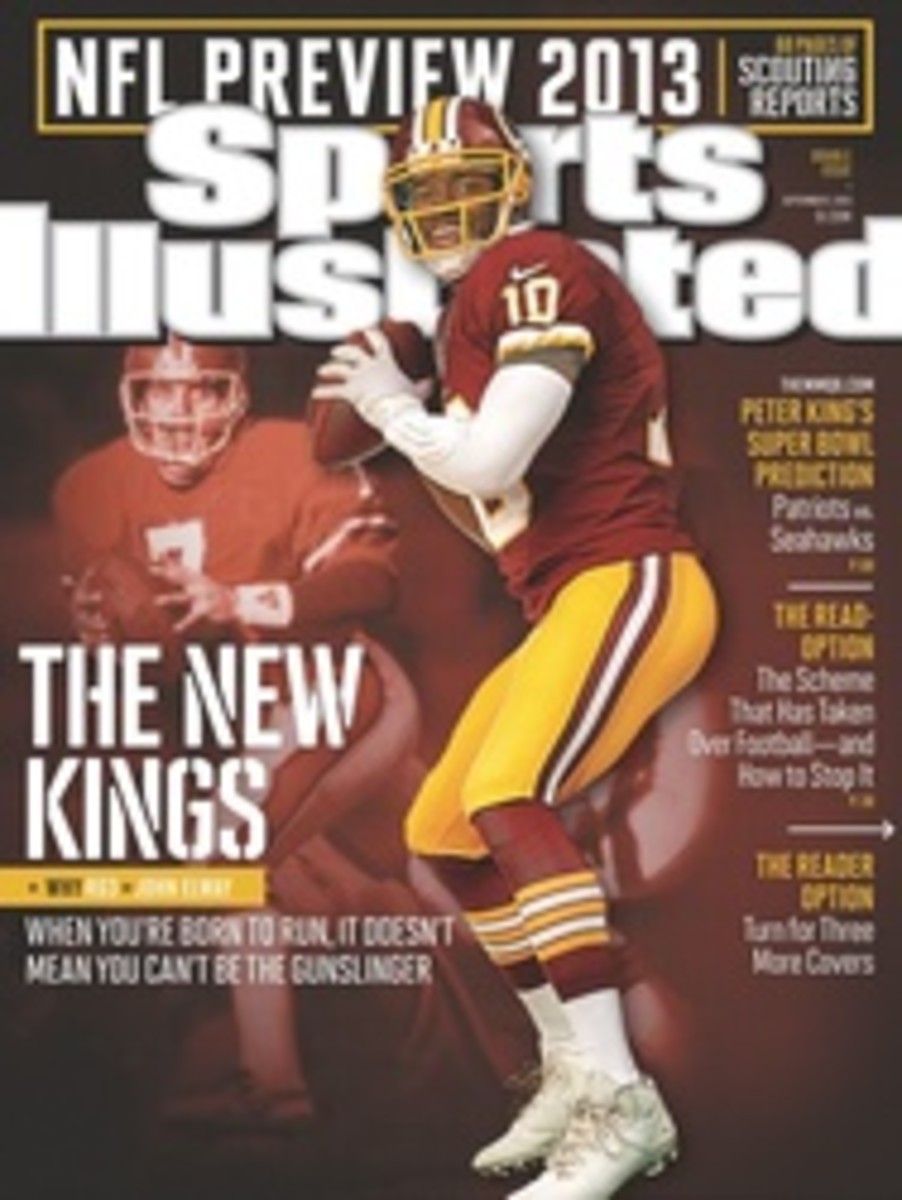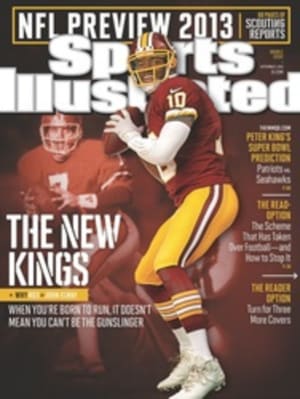
15 New York JETS
FOR NEARLY 30 minutes, Stephen Hill and Jeremy Kerley lingered on the field after a morning training camp session, catching ball after ball from a JUGS machine. How many?
"Infinity," Hill said. "You stay until you get tired."
For a Jets offense that ranked 30th in the league in 2012, the room to improve this season also seems infinite. But from where, exactly, will those improvements come? The team spent its entire three-week camp waiting for either the stumblin', bumblin', butt-fumblin' incumbent, Mark Sanchez, or Geno Smith, the second-round draft pick, to grab the starting QB job with force—but it didn't happen. No matter who lines up under center, however, another question is just as perplexing: Where are the playmakers?
Hill, a second-round pick in 2012, doesn't care much for that question. As Kerley passed him on the way off the practice field one afternoon, Hill gestured at his teammate with his thumb: "This guy right here. That's a weapon. He had 800 yards."
Kerley, in fact, probably is the Jets' best offensive weapon. The third-year receiver led the team by a wide margin last season with 56 catches for 827 yards. More impressive: He caught two thirds of the passes of 20 or more yards sent his way. Given Kerley's past experience (he was a QB in high school and ran the Wild Frog offense at TCU), he's also the player most likely to operate the Wildcat offense that coach Rex Ryan says will again be "part of what we do."
Even with Kerley, there's no question that the Jets still have a dearth of playmakers, a problem that played a large hand in their 6--10 record in 2012. Working on a strict budget, the team did little this off-season to fix that. And unlike their division-rival Patriots, they don't have a Super Bowl--winning QB to mask any deficiencies.
New York's purported No. 1 receiver, Santonio Holmes, has been sidelined since last September with a Lisfranc injury, and the timetable for his return is unclear. Last year's leading rusher, Shonn Greene, and the team's top pass-catcher in two of the past three seasons, tight end Dustin Keller, were not re-signed.
New G.M. John Idzik's free-agent additions included Mike Goodson, an explosive back who missed camp following a May arrest on drug and weapons charges; and tight end Kellen Winslow and receiver Braylon Edwards, two 30-year-olds who combined for 19 catches last season. (Edwards was cut on Monday.) Only two draft picks went toward offensive skill players: Smith and fullback Tommy Bohanon, in the seventh round. The Jets did send a fourth-rounder to New Orleans for running back Chris Ivory, who could be a powerful addition if he stays healthy. But weapons? That's still a work in progress.
The development of Hill, the 6' 4" former Georgia Tech receiver, is the Jets' X factor. The pressure on him started on draft night 2012, when New York's former VP of college scouting invoked Calvin Johnson as a comp for Hill, and it intensified when Holmes was lost for the season in Week 4. That rookie year, in which Hill caught just 21 passes for 252 yards before needing knee surgery in December, didn't quite match expectations. "You're a rookie, you have nerves," says Hill, "but you have to make plays."
The play with which Hill has become most associated is his costly third-down drop against the Patriots last October, but there are signs that he can succeed at this level, like his two-TD 2012 opener against the Bills. He spent camp working on technique adjustments, like his releases off the line, and he's had more than a year to transition from the triple-option offense he played in college. Hill's success hinges on being able to put his unique size and speed to work—and moving on from those drops.
The Jets, whose offense produced just 26 TDs last season, plan to open up the playbook. But creativity by the coaches would only fix one half of their struggles. They still need players who can win one-on-ones, make tacklers miss and deliver in big spots, regardless of who's throwing it.
"We don't care what people say," says Kerley. "We like to be secret assassins. We'd rather people be like, Where are the weapons? And then we sneak up on you."
Implicit in those words is the acknowledgement that the Jets are not working from a position of strength. They are not.
THE CASE FOR ...
The defense
Since Rex Ryan took the reins in 2009, the Jets' D has never placed outside the top 10. And yet something has changed. Those attacking, impose-their-will units that he rode to AFC Championship Games in '09 and '10 have waned the past two seasons while Ryan has ceded play-calling duties to coordinator Mike Pettine and settled into the coach's chair. No longer. The best way for Ryan to lead this team is by making his mark on D, so he's thrown himself back into play-calling, hoping to restore the unit that defined his finest teams. Sure, the Jets traded away their top player, CB Darrelle Revis, but Antonio Cromartie can play at an elite level in his place. The catalyst of change will be the line, stocked with three recent first-round picks—Muhammad Wilkerson (left), Quinton Coples and Sheldon Richardson—who'll get Ryan's hands-on tutelage. In place of Pettine, now in Buffalo, Ryan promoted Dennis Thurman, a longtime co-schemer with a record of getting the most out of his players (see: Cromartie). They'll work off of the old Jets D's from '09 and '10, when blitz-heavy tactics powered the engine. Those units, by the way, ranked No. 1 and No. 3 in the NFL.
SINCE YOU'VE BEEN GONE
PHOTO
RICH KANE/UPI/LANDOV
WR JEREMY KERLEY
PHOTO
TOM DIPACE

